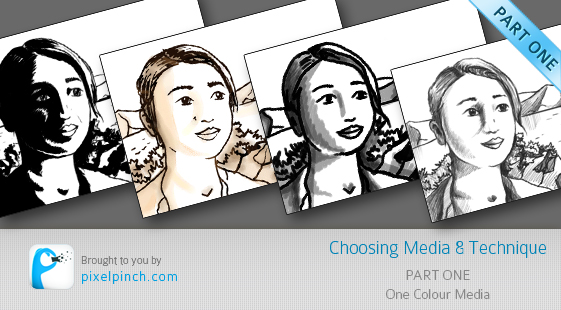Click here if you want to read Part Two.
Lets talk about the coloring mediums and techniques today. There is a huge wealth of artists’ media available in this beautiful world. Even you have found a style or technique suitable for you, it’s worth trying your hand on different tool. It can be argued that it’s better to be the master of one medium that a jack of all trades, but some experience on this will obviously do you no harm.
1. Basic Line Art
To demonstrate how different media can affect an artwork, I have drawn a quick sketch of a girl with mountain and water in the background. Experts say that the fewer lines you use, the more important each line becomes, and an expert will never draw an unnecessary line.
2. Cross-hatching and feathering
Use your favourite pen, pencil or any inking tool and use short repeated strokes to approximately follow the contours of the object. These should be heavier in shadow area, gradating to lighter or less frequent mark in lighter area
This example shows a technical and uniform method of cross-hatching. Straight and parallel lines with mostly 45 degrees in angle are sketched here. There are limitless variation of this technique and you can develop your own.
Here is an another example of cross hatching mixed with watercolour.

3. Chiaroscuro
High contrast between light and shadow in art is known as chiaroscuro. Huge area of artwork is entirely black shadow and bright white highlights. This creates extremely dramatic effect. Details can also be added using pen after spotting with black colour or vice-versa.
4. Stippling
This rendering effect is for very patient artist. The highlight and shadows are done using succession of dots. Closer the dots, you create dark shadows and far apart dots or no dots means highlight.
5. Pencil Half-Toning
Its most used tool and I don’t think it needs any more explanation. Although most used, it is one of the tough media to choose. These pencils have range of softer to hard grades and one must choose wisely their grades. There is technique of smudging it with finger or cloth but some artist don’t smudge. Below is an example of my own pencil sketch.

6. Ink and Brush
Sable brush and Ink can give you a much more fluid line then a pen, going from fine to thick within the same stroke. Brushwork does take longer to master than a pen but once you have the knack, it is a fast & expressive tool to use.
7. Ink and wash
One of my favourite media and I use bamboo tip dip-pen. You can just draw the outline using split-nib dip-pen and also add a dimension by washing it with brush and water. Leave plenty of areas white or the artwork may end up flat.
8. Marker pen
Professional ‘studio’ markers are very expensive and I always wanted it too. But fortunately a single marker can be used in a number of ways. Apply in successive layers to create gradient shadow.
Other techniques which are not covered here are charcoal, chalks, crayons and pastels. Following are some examples of those styles.
 Here is the charcoal jar drawn by me.
Here is the charcoal jar drawn by me.
Below is the pastel drawing drawn by Gwennafran.
Pastel Pencil Girl by *gwennafran on deviantART
Click here if you want to read Part Two.
Do not forget to share your similar stories below in the comments. Also please SHARE this article if you find it useful.

Leave a Reply